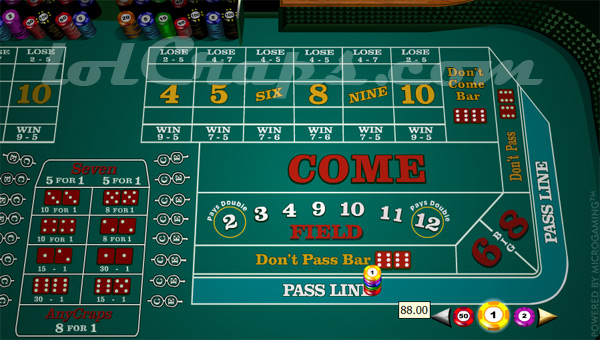Craps Dice Control and Dice Setting
Dice Control, also known as dice setting or controlled shooting is an advanced form of craps strategy. Some could say it is cheating but technically it is just a type of skill that players can use. It is similar to how players use card counting to gain an advantage in blackjack, except players use dice setting techniques to gain an edge in craps. Dice control takes a lot of skill to do and the casinos have a lot of obstacles to hinder the technique.
Basic tutorial for setting the dice
The whole point of dice control is for a player to consistently roll the number that they want. You are trying to build up a fine skill similar to throwing darts or bowling. It is something that takes a lot of practice in order for it to work perfectly. There are all kinds of different strategies that players can use that involve different methods of holding the dice and which fingers you use.
There is some formality to dice setting that players will need to know before starting. These will just be general guidelines for players to follow. If you become serious about dice setting, you will quickly learn that you may do better by deviating from the general guidelines in order to perfect your setting technique and every player just plays differently and is better and certain strategies than others.
First we will start off with the three main concepts of dice setting:
- Hand and Finger Grip
- Dice Alignment
- Throw and Delivery
Grip and handling the dice
The first thing players should do is learn to do is handle the dice in their hands. Basically, this is a combination of the way you grip your fingers around the dice, known as dice grip and how the dice are aligned in your hand, known as dice stacking. Most dice stacking techniques are dependent on which numbers on the dice are next to each other in your hands. I put two links below to other craps coaching sites so you can look at some visual instructional pictures of how you grip the dice. When I get my camera, I will make some pages here with more techniques. Some of these techniques are told to be illegal!
Some basic tips for proper gripping is to not grab onto them too hard. In fact, many experts say that the results turn out better the less often you are touching the dice. What you want to do is to be able to have good control over how the dice spin, but you want to keep minimum contact with the dice. When you throw the dice, you want them to spin in synchrony with each other. The friction and "stickiness" of your fingers can disrupt the balance of the dice along the axis that you throw them. So the less your fingers are in contact with the dice and the less pressure that you exert, the more likely the dice will stay in synchronous spin.
Not only do you want to put little pressure on the dice, you want to put equal pressure on each dice. Ideally, you want to 2 body system of dice to throw as if you are throwing a single rectangular block. The goal is to not have that block break into two pieces as you throw. You also do not want empty space between the two dice when you throw, make sure both of them are touching together solidly, but remember not to squeeze them too hard or apply too much pressure. These gripping techniques will improve your strategy greatly.
Alignment of the dice
Once you got your grip down, you will want to align the dice properly with the table and in your hand. You will be standing on one of the long ends of the table where you will throw down the length of the table. This length is known as the fore-aft axis. The narrow portion of the table (the width) is known as the left-right axis. The height of the dice above the surface of the table is known as the vertical axis.
In order to align the dice, you should use the straight lines displayed on the table. These lines usually make up a systematic grid of squares, rectangles and right angles that are already aligned with the sides of the table. You can use these lines as a system of reference when aligning your dice. Typically, players do not need to worry about aligning the dice with the left-right axis, but the fore-aft axis is the most important as well as the vertical axis.
The first thing you want to do is make sure the dice are level and parallel with the surface of the table. In order to do this properly, it is a good idea to practice by lowering the dice to the table to see if they make square contact with the table. If a corner of the dice touches the table before the other sides, then you are doing it wrong. You want the entire combined surface to touch at the same time. To sum it all up, you just want them level with the table! It may take some practice to get it down good.
Delivering the throw of the dice
One of the rules of the casino is that the dice must be thrown far enough to bounce off the opposite wall of the craps table booth. Many times the dealer will make players re-throw the dice if they do not make contact with the wall. In the past, players could just throw the dice onto the table without hitting the wall and land on certain numbers really easily. The requirement of the dice hitting the wall is used to ensure that a larger factor of randomness is applied to dice throws. To make things even tougher, these padded walls usually have triangular pyramid surfaces or bumps along the sides of the craps table. These are designed to produce even more randomness so that the dice bounce off at different angles. Even these tiny peculiar features that many people would never think of will have major purposes and consequences! You want to eliminate this randomness with dice control.
Ideally, you want to minimize how much the dice move after they touch a surface. You also would prefer the dice to stop rolling immediately after they hit the wall and prefer them not bouncing too hard. Again, the goal is throw the dice and have them spin on an axis together, as if they were glued together as a solid piece. Depending on what type of player you are and your technique, you can be pivoting your wrist, fingers, elbow and shoulder. The less complicated the throw, the less problems that can occur.
One thing to remember is that you should throw the dice in a straight line. If you pivot your shoulder when you make a motion, the dice tends to follow a path of an arc. Players can correct for this by rotating the wrists or making corrections with the elbow. A thing to watch for is when you pivot with the elbow. This sometimes looks unnatural and you never want to do something odd that will draw attention from dealers or employees at the casino.
Tips and advice for dice control
As I stated above, you do not want to get caught by dealers. Technically, dice control is not illegal in casinos but they can still throw you out or ask you to stop playing at the craps table. So the general advice is to not get caught or make yourself too obvious!
Probably the best tip I can give is to just throw the dice straight and get them to spin on the same axis as if they were a single solid piece. If you can get this down good, you will become an excellent dice controller and you will have 95% of the job done. Don't worry about trying to get the grips perfectly with the pictures or trying to throw them exactly like the guides say. It doesn't matter how you do it, if you can throw them so they spin together, than that is it, there is no secret way of doing it.
Now for a few smaller tips for when you are practicing. Watch out for your thumb when throwing the dice. One of the leading causes of the dice breaking apart in midair is the thumb getting in the way or touching the dice right after they leave your hands. You want your thumb to lose contact before the fingers.
Another big problem is having sweaty hands and fingers. This causes them to stick to the dice and cause too much friction when they are thrown, which almost always causes them to break apart in the air. To get rid of this problem, you should wipe the perspiration on your fingers off on your clothes right before throwing. Some pros put chalk in their pockets as a way to dry off the fingers and to be used as an antiperspirant. The problem with chalk is this can usually be spotted by the dealers. Alcohol has also been used by players as well. The main goal is to get your fingers dry before throwing.
Something known as a backspin is used as a way to prevent random movement of the dice after they hit the wall. It is also acts as a counter to forward motion. This is actually a very advanced technique but the basics are still simple. If you can throw a backspin while keeping control of the axis of the dice, you should be just fine.
If you are going to try setting the dice and get into dice control, you do not want to get caught. So the advice is to look as natural as possible and not to look guilty and nervous when you start playing or else the dealer is going to pick up on the tells you are giving off. A good tip is to be social and talk to other players in order to get attention off of yourself. Also handle the dice naturally by bouncing and jiggling them around. You do not want to look like you are handling the dice in a systematic and in a "step by step" textbook fashion. You just need to get so good at it that the whole process is done in a single toss of the dice and no one thinks anything of it.
Finally, the best advice I can give is to practice and practice and then practice some more! You should be doing this at home. First just do some basic stuff like gripping the dice, aligning them level and properly and just throw them on a flat or felt surface. You don't even need to throw them far, just get them to land on the correct numbers that you are trying to throw. Once you can just do this, then start moving up a notch and throw them across the length of a craps table. Eventually you may create or build your own craps table or buy a felt mockup of one to really master it. Then just make your throws like second nature and make it look like it takes no effort and you'll be able to really become an advantage player! The key is to start off basic and simple and practice your way up to become an expert. Remember, a player with good dice control is much harder to catch than card counting, so you could go for years and years without ever worrying about getting caught once you become good enough at it.
If you were curious about craps cheating, you can read our article and learn about cheating at craps. Also learn about fixed dice that can be used to cheat at craps.


 US Players and Credit Card, BitCoin Deposits Accepted!
US Players and Credit Card, BitCoin Deposits Accepted!


